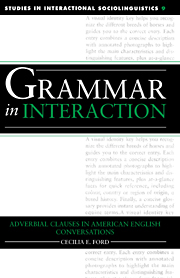Book contents
- Frontmatter
- Contents
- List of illustrations
- List of tables
- Acknowledgements
- Transcription conventions
- 1 Introduction
- 2 Overview of the conversational corpus
- 3 Initial adverbial clauses
- 4 Final versus initial adverbial clauses in continuous intonation
- 5 Final adverbial clauses after ending intonation
- 6 Comparison of clause types and apparent deviations from the general patterns
- 7 Conclusion
- Notes
- References
- Author index
- Subject index
4 - Final versus initial adverbial clauses in continuous intonation
Published online by Cambridge University Press: 09 November 2009
- Frontmatter
- Contents
- List of illustrations
- List of tables
- Acknowledgements
- Transcription conventions
- 1 Introduction
- 2 Overview of the conversational corpus
- 3 Initial adverbial clauses
- 4 Final versus initial adverbial clauses in continuous intonation
- 5 Final adverbial clauses after ending intonation
- 6 Comparison of clause types and apparent deviations from the general patterns
- 7 Conclusion
- Notes
- References
- Author index
- Subject index
Summary
Overview
Unlike initial adverbial clauses in these data, which always end in continuing intonation, when adverbial clauses appear after their associated modified material, they may be connected to that material across continuing or ending intonation. There are 135 final adverbial clauses, making up 66% of the adverbial clauses in the data. Of these final adverbial clauses, 40 (30%) are temporal (when, while, before, after etc.), 18 (13%) are conditional (if), 75 (56%) are causal (because, 'cause), and 2 (1%) are concessive (although, even though).
Eighty (59%) of the final adverbial clauses occur after continuing intonation, while 55 (41%) link back to utterances ending in final falling intonation.
The distinction between continuing and final intonation reflects speakers' decisions to signal that an utterance is not yet completed (continuing intonation), or that an utterance is possibly complete (final intonation). Schiffrin (1987) used this intonation distinction to separate intra-utterance conjunction from inter-utterance conjunction in her analysis of interview data. By distinguishing intra- from inter-utterance intonation patterns, one can describe grammatical connections that occur as parts of intonationally coherent units, and compare these connections to grammatical connections that occur across final intonation boundaries.
In the present chapter I describe the use of adverbial clauses following continuing intonation. In the next chapter, I look at adverbial clauses added to utterances that have been presented as intonationally complete. Final adverbial clauses after continuing intonation are of three types in my corpus: temporal, conditional, and causal. Of these three, only temporal and conditional clauses appear both before and after their main clauses, while causal clauses appear only after the material they modify.
- Type
- Chapter
- Information
- Grammar in InteractionAdverbial Clauses in American English Conversations, pp. 63 - 101Publisher: Cambridge University PressPrint publication year: 1993

